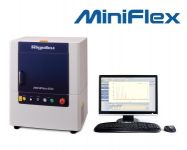MiniFlex
New sixth generation MiniFlex X-ray diffractometer (XRD) is a multipurpose analytical instrument that can determine: phase identification and quantification, percent (%) crystallinity, crystallite size and strain, lattice parameter refinement, Rietveld refinement, and molecular structure. It is widely used in research, especially in material science and chemistry, as well as in industry for research and quality control. It is the newest addition to MiniFlex series of benchtop X-ray diffraction analyzers from Rigaku, which began with the introduction of the original MiniFlex system decades ago.
Advanced HPAD detector: 0D, 1D, and 2D modes
MiniFlex XRD system delivers speed and sensitivity through innovative technology advances, including the HyPix-400 MF 2D hybrid pixel array detector (HPAD) together with an available 600 W X-ray source and new 8-position automatic sample changer. This new direct photon counting detector enables high-speed, low-noise data collection and may be operated in 0D and 1D modes for conventional XRD analysis and 2D mode for samples with coarse grain size and/or preferred orientation. A variety of X-ray tube anodes – along with a range of sample rotation and positioning accessories, together with a variety of temperature attachments – are offered to ensure that the MiniFlex X-ray diffraction (XRD) system is versatile enough to perform challenging qualitative and quantitative analyses of a broad range of samples, whether performing research or routine quality control. The new (Gen 6) MiniFlex X-ray diffractometer system embodies the Rigaku philosophy of “Leading with Innovation” by offering the world’s most advanced benchtop XRD.
Powerful PDXL software is easy-to-use
Each MiniFlex comes standard with the latest version of PDXL, Rigaku's full-function powder diffraction analysis package. The latest version of PDXL offers important new functionality; including a fundamental parameter method (FP) for more accurate peak calculation, phase identification using the Crystallography Open Database (COD), and a wizard for ab inito crystal structure analysis.
MiniFlex X-ray diffractometer history
The Rigaku MiniFlex X-ray diffractometer (XRD) is historically significant in that it was the first commercial benchtop (tabletop) X-ray diffraction instrument. When introduced in 1973, the original Miniflex™ XRD was about one-tenth the size, and dramatically less expensive, than conventional X-ray diffraction (XRD) equipment of the period. The original instrument (Gen 1), and its successor that was introduced in 1976 (Gen 2), employed a horizontal goniometer with data output provided by an internal strip chart recorder. The third generation (Gen 3) instrument, introduced in 1995, was called Miniflex+. It provided a dramatic advance in X-ray power to 450 watts (by operating at 30kV and 15mA) and Windows® PC computer control. Both the Miniflex+ and the succeeding generation products employ a vertical goniometer and allow the use of an automatic sample changer. The fourth generation (Gen 4) Miniflex II instrument was introduced in 2006 and offered the advance of a monochromatic X-ray source and a D/teX Ultra 1D silicon strip detector. The fifth generation (Gen 5) MiniFlex600 system, introduced in 2012, built upon this legacy with 600W of available power and new PDXL powder diffraction software.
Overview:
- New 6th generation design
- Compact, fail-safe radiation enclosure
- Incident beam variable slit
- Simple installation and user training
- Factory aligned goniometer system
- Laptop computer operation
Measurements:
- Phase identification
- Phase quantification
- Percent (%) crystallinity
- Crystallite size and strain
- Lattice parameter refinement
- Rietveld refinement
- Molecular structure
Options:
- 8-position autosampler
- Graphite monochromator
- D/teX Ultra: silicon strip detector
- HyPix-400 MF: 2D HPAD detector
- Air sensitive sample holder
- Travel case









 Print
Print Sent by email
Sent by email



